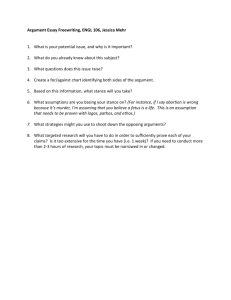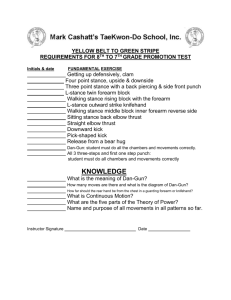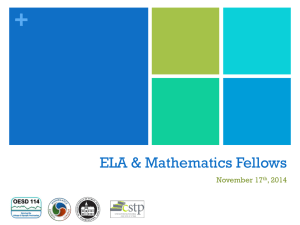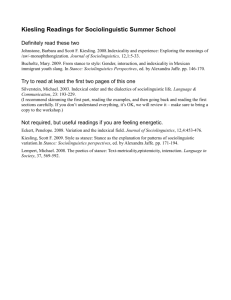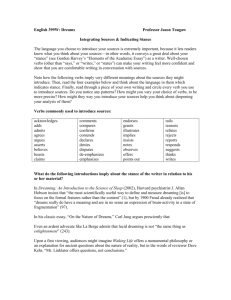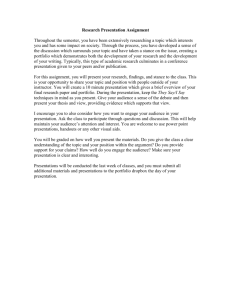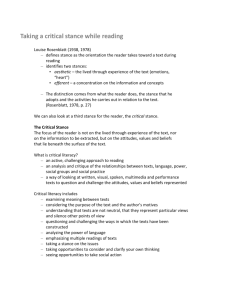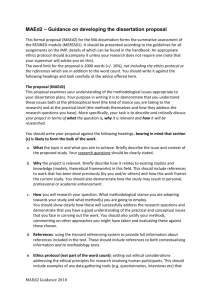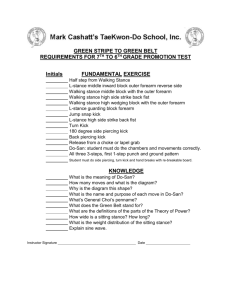Collective Stance Classification of Posts in Online Debate Forums
advertisement
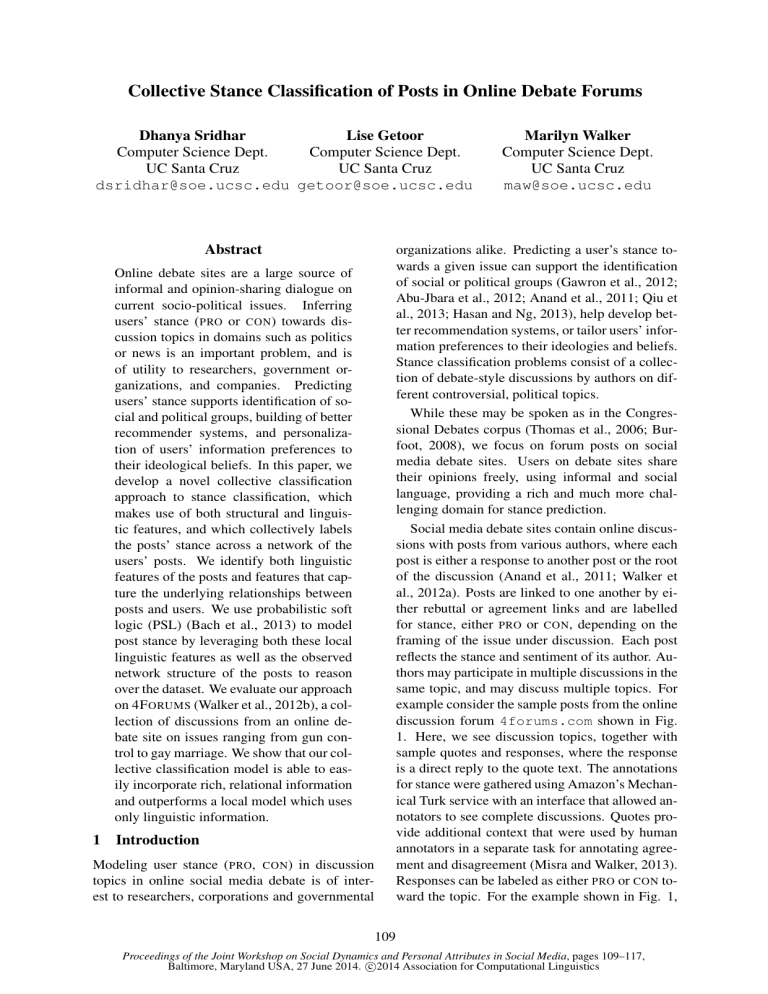
Collective Stance Classification of Posts in Online Debate Forums
Dhanya Sridhar
Lise Getoor
Computer Science Dept.
Computer Science Dept.
UC Santa Cruz
UC Santa Cruz
dsridhar@soe.ucsc.edu getoor@soe.ucsc.edu
Abstract
organizations alike. Predicting a user’s stance towards a given issue can support the identification
of social or political groups (Gawron et al., 2012;
Abu-Jbara et al., 2012; Anand et al., 2011; Qiu et
al., 2013; Hasan and Ng, 2013), help develop better recommendation systems, or tailor users’ information preferences to their ideologies and beliefs.
Stance classification problems consist of a collection of debate-style discussions by authors on different controversial, political topics.
While these may be spoken as in the Congressional Debates corpus (Thomas et al., 2006; Burfoot, 2008), we focus on forum posts on social
media debate sites. Users on debate sites share
their opinions freely, using informal and social
language, providing a rich and much more challenging domain for stance prediction.
Social media debate sites contain online discussions with posts from various authors, where each
post is either a response to another post or the root
of the discussion (Anand et al., 2011; Walker et
al., 2012a). Posts are linked to one another by either rebuttal or agreement links and are labelled
for stance, either PRO or CON, depending on the
framing of the issue under discussion. Each post
reflects the stance and sentiment of its author. Authors may participate in multiple discussions in the
same topic, and may discuss multiple topics. For
example consider the sample posts from the online
discussion forum 4forums.com shown in Fig.
1. Here, we see discussion topics, together with
sample quotes and responses, where the response
is a direct reply to the quote text. The annotations
for stance were gathered using Amazon’s Mechanical Turk service with an interface that allowed annotators to see complete discussions. Quotes provide additional context that were used by human
annotators in a separate task for annotating agreement and disagreement (Misra and Walker, 2013).
Responses can be labeled as either PRO or CON toward the topic. For the example shown in Fig. 1,
Online debate sites are a large source of
informal and opinion-sharing dialogue on
current socio-political issues. Inferring
users’ stance (PRO or CON) towards discussion topics in domains such as politics
or news is an important problem, and is
of utility to researchers, government organizations, and companies. Predicting
users’ stance supports identification of social and political groups, building of better
recommender systems, and personalization of users’ information preferences to
their ideological beliefs. In this paper, we
develop a novel collective classification
approach to stance classification, which
makes use of both structural and linguistic features, and which collectively labels
the posts’ stance across a network of the
users’ posts. We identify both linguistic
features of the posts and features that capture the underlying relationships between
posts and users. We use probabilistic soft
logic (PSL) (Bach et al., 2013) to model
post stance by leveraging both these local
linguistic features as well as the observed
network structure of the posts to reason
over the dataset. We evaluate our approach
on 4F ORUMS (Walker et al., 2012b), a collection of discussions from an online debate site on issues ranging from gun control to gay marriage. We show that our collective classification model is able to easily incorporate rich, relational information
and outperforms a local model which uses
only linguistic information.
1
Marilyn Walker
Computer Science Dept.
UC Santa Cruz
maw@soe.ucsc.edu
Introduction
Modeling user stance (PRO, CON) in discussion
topics in online social media debate is of interest to researchers, corporations and governmental
109
Proceedings of the Joint Workshop on Social Dynamics and Personal Attributes in Social Media, pages 109–117,
Baltimore, Maryland USA, 27 June 2014. c 2014 Association for Computational Linguistics
Quote Q, Response R
Q: I thought I’d start a new thread for those newcomers who don’t want to be shocked by sick
minded nazi XXXX. Anyway... When are fetuses really alive, and how many fetuses are actually
aborted (murdered) before that time?
R: The heart starts beating 3 weeks after conception, and you can’t live without a beating heart,
but me personally, I think that as soon as the miracle starts, (egg and sperm combine) that is
when life begins. I know it’s more of a spiritual thing for me instead of a fact. :)
Q2: Most americans support a Federal Marriage Amendment. Defining Marriage as a union
between a man and a woman. Federal Marriage Amendment. This is the text of the Amend:
Marriage in the United States shall consist only of the union of a man and a woman. Neither
this constitution or the constitution of any state, nor state or federal law, shall be construed to
require that marital status or the legal incidents thereof be conferred upon unmarried couples or
groups.
R2: Debator, why does it bother you so much that some people are gay? Its a sexual prefference.
People like certain things when they have sex. Example: A man likes a women with small boobs.
Or, a man likes a women with nice legs. People like the way certain things feel (I’m not giving
te example for that one;) ). So why does it bother people that someone’s sexual prefference is
just a little kinkier than thiers?
Stance
Topic
CON
Abortion
P RO
Gay
Marriage
Figure 1: Sample Quote/Response Pair from 4forums.com with Mechanical Turk annotations for stance.
Both response posts are from the same author.
2
both response posts are from the same author. We
describe the dataset further in Section 4.1.
Overview of Approach
Given a set of topics {t1 . . . tn }, where each topic
ti consists of a set of discussions {di1 . . . dij }, we
model each discussion dk as a collection of posts
{pk0 , . . . , pkm }, where each post pki is mapped to
its author ai .
A discussion di ∈ D is a tree of posts, starting
with the initial post pi0 . We distinguish between
posts that start a new thread (root) and others (nonroot). Each non-root post pij is the response to
some previous post pik , where k < j, and we refer
to pik as the parent of pij . For a subset of the posts,
pij has been annotated with a real valued number
in the interval [−5, 5] that denotes whether the post
disagrees or agrees with its parent. Values ≤ 0 are
considered disagreement and values ≥ 1, as agreement. We discard the posts where the annotations
are in the interval (0, 1) since those indicate high
annotator uncertainty about agreement.
Fig. 2 illustrates an example of three discussion
trees for two topics where author a2 participates
in multiple discussions of the same topic and a3
and a4 participate in multiple topics. An author
directly replies with a post to another author’s post
and either disagrees or agrees.
Each post pij in discussion di is also mapped to
{xij1 , . . . , xijN } linguistic features as described in
Section 3.2.1 as well as yij , the stance label (PRO,
CON) towards the discussion topic ti .
We say that aj participates in topic ti if there
exist any posts pj ∈ di with author aj .
Using the tree structure and posts that have annotations for agreement or disagreement, we con-
We believe that models of post stance in online debate should capture both the content and the
context of author posts. By jointly reasoning over
both the content of the post and its relationships
with other posts in the discussion, we perform collective classification, as we further define in Section 3 (Sen et al., 2008). Previous work has shown
that collective classification models often perform
better than content-only approaches. (Burfoot et
al., 2011; Hasan and Ng, 2013; Thomas et al.,
2006; Bansal et al., 2008; Walker et al., 2012c).
Here, we develop a collective classification approach for stance prediction which leverages the
sentiment conveyed in a post through its language,
and the reply links consisting of agreements or rebuttals between posts in a discussion. We implement our approach using Probabilistic Soft Logic
(PSL) (Bach et al., 2013), a recently introduced
tool for collective inference in relational data. We
evaluate our model on data from the 4F ORUMS
online debate site (Walker et al., 2012b).
Section 2 first presents an overview of our approach and then in Section 3.1 we describe the
PSL framework in more detail. Section 4 describes the evaluation data and our results showing that the PSL model improves prediction of post
stance in the 4Forums dataset. In Section 5 we
describe related work, and compare with our proposed approach. Section 6 summarizes our approach and results.
110
Figure 2: Example of 3 discussions in (a), (b) and (c). Dotted lines denote the ‘writes’ relation between
authors and posts and dashed lines denote the ‘disagrees’ relation between posts and between authors.
Authors can participate in multiple discussions of the same topic, shown by a2 in both (a) and (b).
Moreover, authors may post in multiple topics, as shown by a3 and a4 in both (b) and (c), and may
interact with the same authors multiple times, as shown again in (b) and (c).
3.1
sider the network graph G of disagreement and
agreement between posts and between authors,
where the vertices are posts {p0 , . . . , pm } and authors {a0 , . . . , an }. A disagreement edge exists
from post pu to pv if pu disagrees with pv .
A disagreement edge exists from aw to ay if any
of the posts {pw , . . . , px } mapped to aw disagree
with any posts {py , . . . pz } mapped to ay . We similarly define agreement edges for both posts and
authors.
3
Probabilistic Soft Logic
Probabilistic soft logic (PSL) is a framework for
probabilistic modeling and collective reasoning in
relational domains (Kimmig et al., 2012; Bach et
al., 2013). PSL provides a declarative syntax and
uses first-order logic to define a templated undirected graphical model over continuous random
variables. Like other statistical relational learning methods, dependencies in the domain are captured by constructing rules with weights that can
be learned from data.
But unlike other statistical relational learning
methods, PSL relaxes boolean truth values for
atoms in the domain to soft truth values in the interval [0,1]. In this setting, finding the most probable explanation (MPE), a joint assignment of truth
values to all random variable ground atoms, can be
done efficiently.
For example, a typical PSL rule looks like the
following:
Collective Classification of Stance
Given the discussion structure defined in the previous section, our task is to infer the stance of each
post. We make use of both linguistic features and
the relational structure in order to collectively or
jointly infer the stance labels. This corresponds to
a collective classification setting (Sen et al., 2008),
in which we are given a multi-relational network
and some partially observed labels, and we wish
to infer all of the unobserved labels, conditioned
on observed attributes and links. Collective classification refers to the combined classification of
a set of interdependent objects (posts, in our domain) using information given by both the local
features of the objects and the properties of the
objects’ neighbors in a network. For the stance
classification problem, we infer stance labels for
posts using both the correlation between a post and
its linguistic attributes {xij1 , . . . , xijN }, and the
labels and attributes of its neighbors in observed
network graph G. We use PSL, described below,
to perform collective classification.
P (A, B) ∧ Q(B, C) → R(A, C)
where P, Q and R are predicates that represent
observed or unobserved attributes in the domain,
and A, B, and C are variables. For example, in
our 4F ORUMS domain, we consider an observed
attribute such as writesPost(A, P) and infer an unobserved attribute (or label) such as isProPost(P,
T). Instantiation of predicates with data is called
grounding (e.g. writesPost(A2, P7)), and each
ground predicate, often called ground atom, has a
soft truth value in the interval [0,1]. To build a PSL
model for stance classification, we represent posts
111
isProPost(P, T) ∧ writesPost(A, P)
¬ isProPost(P, T) ∧ writesPost(A, P)
agreesPost(P, P2) ∧ isProPost(P, T)
agreesPost(P, P2) ∧¬ isProPost(P, T)
disagreesPost(P, P2) ∧ isProPost(P, T)
disagreesPost(P, P2) ∧¬ isProPost(P, T)
agreesAuth(A, A2) ∧ isProAuth(A, T)
agreesAuth(A, A2) ∧¬ isProAuth(A, T)
disagreesAuth(A, A2) ∧ isProAuth(A, T)
disagreesAuth(A, A2) ∧¬ isProAuth(A, T)
hasLabelPro(P, T)
¬ hasLabelPro(P, T)
→
→
→
→
→
→
→
→
→
→
→
→
isProAuth(A, T)
¬ isProAuth(A, T)
isProPost(P2, T)
¬ isProPost(P2, T)
¬ isProPost(P2, T)
isProPost(P2, T)
isProAuth(A, T)
¬ isProAuth(A2, T)
¬ isProAuth(A2, T)
isProAuth(A2, T)
isProPost(P, T)
¬ isProPost(P, T)
Table 1: Rules for PSL model, where P = post, T = Topic, and A = Author.
2001). Basic length features capture the number
of sentences, words, and characters, along with
the average word and sentence lengths for each
post. The discourse cues feature captures frequency counts for the first few words of the post,
which often contain discourse cues. To capture
the information in repeated punctuation like “!!”,
“??” or “?!” we include the frequency count of the
given punctuation patterns as a feature of each post
(Anand et al., 2011). LIWC counts capture sentiment by giving the degree to which the post uses
certain categories of subjective language.
and authors as variables and specify predicates to
encode different interactions, such as writes, between them. Domain knowledge is captured by
writing rules with weights that govern the relative importance of the dependencies between predicates. The groundings of all the rules result in
an undirected graphical model that represents the
joint probability distribution of assignments for all
unobserved atoms, conditioned on the observed
atoms.
Triangular norms, which are continuous relaxations of logical AND and OR, are used to combine the atoms in the first-order clauses. As a
result of the soft truth values and the triangular norms, the underlying probabilistic model is
a hinge-loss Markov Random Field (HL-MRF).
Inference in HL-MRFs is a convex optimization,
which leads to a significant improvement in efficiency over discrete probabilistic graphical models. Thus, PSL offers a very natural interface to
compactly represent stance classification as a collective classification problem, along with methods
to reason about our domain.
3.2
3.2.2
As our problem domain contains relations between both authors and posts, for our PSL model,
we consider the relations between authors, between posts and between authors and posts. As described above, in PSL, we model these relations as
first-order predicates. In Section 3.3, we describe
how we populate the predicates with observations
from our data.
Author Information We observe that authors
participate in discussions by writing posts. For
a subset of authors, we have annotations for their
interactions with other authors as either disagreement or agreement, as given by network graph
G. We encode this with the following predicates: writesPost(A, P), disagreesAuth(A1, A2),
agreesAuth(A1, A2).
Features
We extract both linguistic features that capture the
content of a post and features that capture multiple
relations from our dataset.
3.2.1
Relational Information
Linguistic Features
To capture the content of a post, on top of a bag-ofwords representation with unigrams and bigrams,
we also consider basic lengths, discourse cues,
repeated punctuation counts and counts of lexical categories based on the Linguistic Inquiry
and Word Count tool (LIWC) (Pennebaker et al.,
Post Information Posts are linked to the topic
of their given discussion, and to other posts in
their discussion through disagreement or agreement. Additionally, we include a predicate for post
stance towards its topic as predicted by a classifier
112
Topic
Abortion
Evolution
Gun Control
Gay Marriage
Death Penalty
that only uses linguistic features, as described in
Section 3.3, as prior information. We capture these
relations with the following predicates: hasLabelPro(P, T), hasTopic(P, T), disagreesPost(P1, P2),
agreesPost(P1, P2).
3.2.3
Target attributes
Our goal is to 1) predict the stance relation between a post and its topic, namely, PRO or CON and
2) predict the stance relation between an author
and a topic. In our PSL model, our target predicates are isProPost(P, T) and isProAuth(A, T).
3.3
Authors
385
325
319
316
170
Posts
8114
6186
3899
7025
572
Table 2: Overview of topics in 4F ORUMSdataset.
4
Experimental Evaluation
We first describe the dataset we use for evaluation
and then describe our evaluation method and results.
PSL Model
We construct our collective stance classification
model in PSL using the predicates listed above.
For disagreement/agreement annotations in the interval [-5, 5], we consider values [-5,0] as evidence
for the disagreesAuth relation and values [1, 5] as
evidence for the agreesAuth relation. We discard
observations with annotations in the interval [0,1]
because it indicates a very weak signal of agreement, which is already rare on debate sites. We
populate disagreesPost and agreesPost in the same
way as described above.
For each relation, we populate the corresponding predicate with all the instances that we observe
in data and we fix the truth value of each observation as 1. For all such predicates where we observe
instances in the data, we say that the predicate is
closed. For the relations isPostPro and isAuthPro
that we predict through inference, a truth value of
1 denotes a PRO stance and a truth value of 0 denotes a CON stance. We say that those predicates
are open, and the goal of inference is to jointly assign truth values to groundings of those predicates.
We use our domain knowledge to describe rules
that relate these predicates to one another. We follow our intuition that agreement between nodes
implies that they have the same stance, and disagreement between nodes implies that they have
opposite stances. We relate post and author nodes
to each other by supposing that if a post is PRO
towards its topic, then its author will also be PRO
towards that topic.
We construct a classifier that takes as input the
linguistic features of the posts and outputs predictions for stance label of each post. We then consider the labels predicted by the local classifier as
a prior for the inference of the target attributes in
our PSL model. Table 1 shows the rules in our
PSL model.
4.1
Dataset
We evaluate our proposed approach on discussions from https://www.4forums.com, an
online debate site on social and political issues.
The dataset is publicly available as part of the
Internet Argument Corpus, an annotated collection of 109,533 forum posts (Walker et al., 2012b;
Walker et al., 2012c). On 4F ORUMS, a user initiates a discussion by posting a new question or
comment under a topic, or participate in an ongoing discussion by replying to any of the posts in
the thread. The discussions were given to English
speaking Mechanical Turk annotators for a number of annotation tasks to get labels for the stances
of discussion participants towards the topic, and
scores for each post in a discussion indicating
whether it is in agreement or disagreement with
the preceding post.
The scores for agreement and disagreement
were on a 11 point scale [-5, 5] implemented using
a slider, and annotators were given quote/response
pairs to determine if the response text agreed
or disagreed with the quote text. We use the
mean score across the 5-7 annotators used in the
task. A more negative value indicates higher
inter-annotator confidence of disagreement, and a
more positive value indicates higher confidence of
agreement. The gold-standard annotation used for
the stance label of each post is given by the majority annotation among 3-8 Mechanical Turk annotators performed as a separate task, using entire discussions to determine the stance of the authors in the discussion towards the topic. We use
the stance of each post’s author to determine the
post’s stance. For our experiments, we use all
posts with annotations for stance, and about 90%
of these posts also have annotations for agree113
topics. Our PSL model outperforms the LOCAL
model, with statistically significant improvements
in the F1 score and AUC-PR for the negative class.
Moreover, our model completes weight learning
and inference on the order of seconds, boasting an
advantage in computational efficiency, while also
maintaining model interpretability.
Table 4 shows the weights learned by the PSL
model for the rules in one of the train/test splits
of the experiment. The first two rules relating
post stance and author stance are weighted more
heavily, in part because the writesPost predicate
has a grounding for each author-post pair and contributes to lots of groundings of the rule. The rules
that capture the alternating disagreement stance
also have significant weight, while the rules denoting agreement both between posts and between authors are weighted least heavily since there are far
fewer instances of agreement than disagreement.
This matches our intuition of political debates.
We also explored variations of the PSL model
by removing the first two rules relating post stance
and author stance and found that the weight learning algorithm drove the weights of the other
rules close to 0, worsening the performance.
We also removed rules 3-10 that capture agreement/disagreement from the model, and found that
the model performs poorly when disregarding the
links between nodes entirely. The PSL model
learns to weight the first and second rule very
highly, and does worse than when considering the
prior alone. Thus, the combination of the rules
gives the model its advantage, allowing the PSL
model to make use of a richer structure that has
multiple types of relations and more information.
ment/disagreement.
The discussions span many topics, and Table 2
gives a summary of the topics we consider in our
experiments and the distribution of posts across
these topics. Each post in a discussion comes as
a quote-response pair, where the quote is the text
that the post is in response to, and the response is
the post text. We refer to (Walker et al., 2012b) for
a full description of the corpus and the annotation
process.
4.2
Evaluation
In order to evaluate our methods, we split the
dataset into training and testing sets by randomly
selecting half the authors from each topic and their
posts for the training set and using the remaining
authors and their posts for the test set. This way,
we ensure that no two authors appear in both training and test sets for the same topic, since stance
is topic-dependent. We create 10 randomly sampled train/test splits for evaluation. Each split contains about 18,000 posts. For each train/test split,
we train a linear SVM for each topic, with the
L2-regularized-L1-loss SVM implemented in the
LibLINEAR package (Fan et al., 2008). We use
only the linguistic features from the posts, for each
topic in the training set. We refer to the baseline
model which only uses the the output of the SVM
as the LOCAL model. We output the predictions
from LOCAL model and get stance labels for posts
in both the training and test sets. We use the predictions as prior information for the true stance label in our PSL model, with the hasLabel predicate.
We use the gold standard stance annotation
(PRO, CON) for each post as ground truth for
weight learning and inference. A truth value of 1
for isPostPro and isAuthPro denotes a PRO stance
and a truth value of 0 denotes a CON stance. We
learn the weights of our PSL model (initially set to
1) for each of our training sets and perform inference on each of the test sets.
Table 3 shows averages for F1 score for the positive class (PRO), area under the precision-recall
curve (AUC-PR) for the negative class (CON) and
area under the ROC curve (AUROC) over the 10
train/test splits. For the PSL model, the measures
are computed for joint inference over all topics
in the test sets. For the per-topic linear SVMs
(LOCAL model), we compute the measures individually for the predictions of each topic in the
test sets and take a weighted average over the
5
Related Work
Over the last ten years, there has been significant
progress on modeling stance. Previous work covers three different debate settings: (1) congressional debates (Thomas et al., 2006; Bansal et
al., 2008; Yessenalina et al., 2010; Balahur et al.,
2009); (2) company-internal discussion sites (Murakami and Raymond, 2010; Agrawal et al., 2003);
and (3) online social and political public forums
(Somasundaran and Wiebe, 2009; Somasundaran
and Wiebe, 2010; Wang and Rosé, 2010; Biran
and Rambow, 2011; Walker et al., 2012c; Anand
et al., 2011). Debates in online public forums
(e.g. Fig. 1) differ from debates in congress and
on company discussion sites because the posts are
114
Classifier
LOCAL
PSL
F1 Score
0.66 ± 0.015
0.74 ± 0.04
AUC-PR negative class
0.44 ± 0.04
0.511 ± 0.04
AUROC
0.54 ± 0.02
0.59 ± 0.05
Table 3: Averages and standard deviations for F1 score for the positive class, area under PR curve for the
negative class, and area under ROC curve for post stance over 10 train/test splits.
isProPost(P, T) ∧ writesPost(A, P)
¬ isProPost(P, T) ∧ writesPost(A, P)
agreesPost(P, P2) ∧ isProPost(P, T)
agreesPost(P, P2) ∧¬ isProPost(P, T)
disagreesPost(P, P2) ∧ isProPost(P, T)
disagreesPost(P, P2) ∧¬ isProPost(P, T)
agreesAuth(A, A2) ∧ isProAuth(A, T)
agreesAuth(A, A2) ∧¬ isProAuth(A, T)
disagreesAuth(A, A2) ∧ isProAuth(A, T)
disagreesAuth(A, A2) ∧¬ isProAuth(A, T)
hasLabelPro(P, T)
¬ hasLabelPro(P, T)
→
→
→
→
→
→
→
→
→
→
→
→
isProAuth(A, T) : 10.2
¬ isProAuth(A, T) : 8.5
isProPost(P2, T) : 0.003
¬ isProPost(P2, T) : 0.003
¬ isProPost(P2, T) : 0.06
isProPost(P2, T) : 0.11
isProAuth(A, T) : 0.001
¬ isProAuth(A2, T) : 0.0
¬ isProAuth(A2, T) : 0.23
isProAuth(A2, T) : 0.6
isProPost(P, T) : 2.2
¬ isProPost(P, T) : 4.8
Table 4: Weights learned by the model for the PSL rules in train/test split 2 of experiments
apply the PSL collective classification framework
to the forums conversations from the IAC corpus
(Anand et al., 2011; Walker et al., 2012c).
shorter and the language is more informal and social. We predict that this difference makes it more
difficult to achieve accuracies as high for 4F O RUMS discussions as can be achieved for the congressional debates corpus.
6
Work by (Somasundaran and Wiebe, 2009) on
idealogical debates very similar to our own show
that identifying argumentation structure improves
performance; their best performance is approximately 64% accuracy over all topics. Research by
(Thomas et al., 2006; Bansal et al., 2008; Yessenalina et al., 2010; Balahur et al., 2009) classifies
the speaker’s stance in a corpus of congressional
floor debates. This work combines graph-based
and text-classification approaches to achieve 75%
accuracy on Congressional debate siding over all
topics. Other work applies MaxCut to the reply structure of company discussion forums (Malouf and Mullen, 2008; Murakami and Raymond,
2010; Agrawal et al., 2003). Murakami & Raymond (2010) show that rules for identifying agreement, defined on the textual content of the post
improve performance.
Discussion and Future Work
Here, we introduce a novel approach to classify
stance of posts from online debate forums with a
collective classification framework. We formally
construct a model, using PSL, to capture relational
information in the network of authors and posts
and our intuition that agreement or disagreement
between users correlates to their stance towards a
topic. Our initial results are promising, showing
that by incorporating more complex interactions
between authors and posts, we gain improvements
over a content-only approach. Our approach is
ideally suited to collective inference in social media. It easily extendable to use additional relational information, and richer behavioral and linguistic information.
Acknowledgments
Thanks to Pranav Anand for providing us with the
stance annotations for the 4forums dataset. This
work is supported by National Science Foundation
under Grant Nos. IIS1218488, CCF0937094 and
CISE-RI 1302668.
More recent work has explicitly focused on the
benefits of collective classification in these settings (Burfoot et al., 2011; Hasan and Ng, 2013;
Walker et al., 2012c), and has shown in each
case that collective classification improves performance. The results reported here are the first to
115
References
Angelika Kimmig, Stephen H. Bach, Matthias
Broecheler, Bert Huang, and Lise Getoor. 2012.
A short introduction to probabilistic soft logic.
In NIPS Workshop on Probabilistic Programming:
Foundations and Applications.
Amjad Abu-Jbara, Mona Diab, Pradeep Dasigi, and
Dragomir Radev. 2012. Subgroup detection in ideological discussions. In Association for Computational Linguistics (ACL), pages 399–409.
R. Malouf and T. Mullen. 2008. Taking sides: User
classification for informal online political discourse.
Internet Research, 18(2):177–190.
R. Agrawal, S. Rajagopalan, R. Srikant, and Y. Xu.
2003. Mining newsgroups using networks arising
from social behavior. In International Conference
on World Wide Web (WWW), pages 529–535. ACM.
Amita Misra and Marilyn A Walker. 2013. Topic independent identification of agreement and disagreement in social media dialogue. In Conference of the
Special Interest Group on Discourse and Dialogue,
page 920.
Pranav Anand, Marilyn Walker, Rob Abbott, Jean E.
Fox Tree, Robeson Bowmani, and Michael Minor.
2011. Cats Rule and Dogs Drool: Classifying
Stance in Online Debate. In ACL Workshop on Sentiment and Subjectivity.
A. Murakami and R. Raymond. 2010. Support or Oppose? Classifying Positions in Online Debates from
Reply Activities and Opinion Expressions. In International Conference on Computational Linguistics
(ACL), pages 869–875.
Stephen H. Bach, Bert Huang, Ben London, and Lise
Getoor. 2013. Hinge-loss markov random fields:
Convex inference for structured prediction. In Uncertainty in Artificial Intelligence (UAI).
J. W. Pennebaker, L. E. Francis, and R. J. Booth, 2001.
LIWC: Linguistic Inquiry and Word Count.
A. Balahur, Z. Kozareva, and A. Montoyo. 2009. Determining the polarity and source of opinions expressed in political debates. Computational Linguistics and Intelligent Text Processing, pages 468–480.
Minghui Qiu, Liu Yang, and Jing Jiang. 2013. Modeling interaction features for debate side clustering.
In ACM International Conference on Information &
Knowledge Management (CIKM), pages 873–878.
M. Bansal, C. Cardie, and L. Lee. 2008. The power
of negative thinking: Exploiting label disagreement
in the min-cut classification framework. COLING,
pages 13–16.
Prithviraj Sen, Galileo Mark Namata, Mustafa Bilgic,
Lise Getoor, Brian Gallagher, and Tina Eliassi-Rad.
2008. Collective classification in network data. AI
Magazine, 29(3):93–106.
O. Biran and O. Rambow. 2011. Identifying justifications in written dialogs. In IEEE International
Conference on Semantic Computing (ICSC), pages
162–168.
S. Somasundaran and J. Wiebe. 2009. Recognizing stances in online debates. In ACL and AFNLP,
pages 226–234.
Clinton Burfoot, Steven Bird, and Timothy Baldwin.
2011. Collective classification of congressional
floor-debate transcripts. In Association for Computational Linguistics (ACL), pages 1506–1515.
S. Somasundaran and J. Wiebe. 2010. Recognizing
stances in ideological on-line debates. In NAACL
HLT 2010 Workshop on Computational Approaches
to Analysis and Generation of Emotion in Text,
pages 116–124.
C. Burfoot. 2008. Using multiple sources of agreement information for sentiment classification of political transcripts. In Australasian Language Technology Association Workshop, volume 6, pages 11–
18.
M. Thomas, B. Pang, and L. Lee. 2006. Get out the
vote: Determining support or opposition from Congressional floor-debate transcripts. In Conference
on Empirical Methods in Natural Language Processing (EMNLP), pages 327–335.
Rong-En Fan, Kai-Wei Chang, Cho-Jui Hsieh, XiangRui Wang, and Chih-Jen Lin. 2008. LIBLINEAR:
A library for large linear classification. Journal of
Machine Learning Research, 9:1871–1874.
Marilyn Walker, Pranav Anand, Rob Abbott, Jean E.
Fox Tree, Craig Martell, and Joseph King. 2012a.
That’s your evidence?: Classifying stance in online
political debate. Decision Support Sciences.
J.M. Gawron, D. Gupta, K. Stephens, M.H. Tsou,
B. Spitzberg, and L. An. 2012. Using group membership markers for group identification in web logs.
In AAAI Conference on Weblogs and Social Media
(ICWSM).
Marilyn Walker, Pranav Anand, Robert Abbott, and
Jean E. Fox Tree. 2012b. A corpus for research
on deliberation and debate. In Language Resources
and Evaluation Conference, LREC2012.
Marilyn Walker, Pranav Anand, Robert Abbott, and
Richard Grant. 2012c. Stance classification using
dialogic properties of persuasion. In Meeting of the
North American Association for Computational Linguistics. NAACL-HLT12.
Kazi Saidul Hasan and Vincent Ng. 2013. Stance classification of ideological debates: Data, models, features, and constraints. International Joint Conference on Natural Language Processing.
116
Y.C. Wang and C.P. Rosé. 2010. Making conversational structure explicit: identification of initiationresponse pairs within online discussions. In Human
Language Technologies: The 2010 Annual Conference of the North American Chapter of the Association for Computational Linguistics, pages 673–676.
A. Yessenalina, Y. Yue, and C. Cardie.
2010.
Multi-level structured models for document-level
sentiment classification. In Conference on Empirical Methods in Natural Language Processing
(EMNLP), pages 1046–1056.
117
